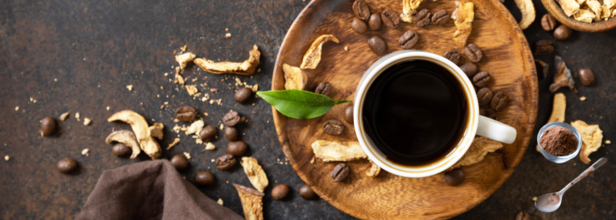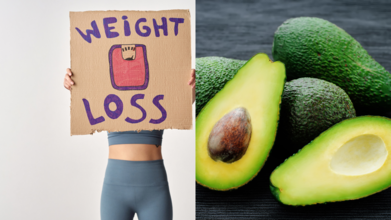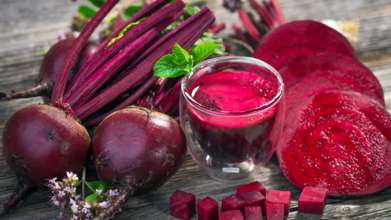- Health Conditions A-Z
- Health & Wellness
- Nutrition
- Fitness
- Health News
- Ayurveda
- Videos
- Medicine A-Z
- Parenting
- Web Stories
Should You Drink Your Morning Coffee With Protein?

Credits: canva
Is it okay to have protein with a cup of your morning coffee? Or can it react badly to your health? Coffee and protein are beneficial for your health and enhance your day's performance. But can it be consumed together? Let's find out.
Coffee and its benefits
Coffee is an antioxidant-rich substance that can help combat oxidative stress. A 2017 study titled Coffee consumption and health: umbrella review of meta-analyses of multiple health outcomes reveals that oxidative stress is linked to many chronic diseases like heart disease, diabetes, and cancer and the consumption of coffee can combat such risks. Furthermore, another 2021 study published in the Journal of the International Society of Sports Nutrition reveals that drinking coffee also improves physical performance and weight management.
Protein and its benefits
It is not unknown that protein is helpful for the proper growth of the human body, and repairs and maintains tissues and muscle tissues. It is also important and helps in producing enzymes, hormones and molecules that help the body to function properly.
So, can you enjoy both?
Another study published in the Journal of the International Society of Sports Nutrition states that for active adults, a daily intake of 1.4-2.0 grams of protein per kilogram of body weight is enough to build and maintain muscle mass. Protein also plays an important role in muscle recovery, strength and repairing muscle tissue.
Studies also show that caffeine, which is the primary and active compound in coffee can improve aerobic endurance, support muscle contraction and delay muscle fatigue. It can be consumed with doses of 3 to 6 milligrams of caffeine per kilogram of body weight.
When can you have coffee and protein together?
The best time to pair these two can depend on your daily schedule and exercise routine. Consuming coffee in the morning or early afternoon helps one avoid disruption, focus on work and drive away sleep. However, if taken at night, it can interfere one's sleep cycle and reduce the levels of 6-sulfatoxymelatonin, which is the primary metabolite of melatonin, the hormone which is important for regulating sleep patterns.
Research also suggests that physically active people can consume coffee for about 60 minutes before they go for exercise as the blood levels of caffeine reach the maximum value 60 minutes after its ingestion. While for protein, it can be consumed regularly throughout the day as a part of a well-balanced diet to meet your daily protein needs.
Other benefits
Consuming both together can help with weight loss as studies have shown that eating more protein can reduce body fat, and prevent muscle loss. Preserving muscle mass is important as it helps your body burn more calories even when you are resting.
Protein can help curb your appetite by promoting feelings of fullness. It boosts hormones like glucagon-like peptide-1 and cholecystokinin, which suppress hunger while reducing ghrelin, the hormone that triggers it. Similarly, chlorogenic acid—a natural compound in coffee—supports fat loss by increasing energy expenditure and enhancing fat burning.
Good sources of protein can be found in cottage cheese, Greek yoghurt, eggs, tofu, turkey sausage, salmon, quinoa, peanut butter, Amarnath, pumpkin seeds and hemp seeds.
Coffee and protein are also known to improve one's cognitive function. This is because caffeine acts as a stimulant that increases alertness, attention, and reaction time. It also blocks adenosine receptors in the brain and delays the feeling of tiredness.
Are there any health risks?
Coffee can interfere the mineral absorption, especially iron. Research has also shown that consuming three cups of coffee can also reduce ferritin levels, the proteins which are responsible for storing iron in the body. There also could be heavy metal contamination in protein powders, many of which are not regulated by the United States Food and Drug Administration (FDA). This is why it is important to choose the protein powder after research and consume both in moderation.
Does How You Eat Avocado Affect Its Weight-Loss Benefits?

Credits: Canva
From sourdough toast to green smoothies, this creamy fruit has secured its spot as a global wellness icon. Packed with healthy fats, fibre, and enough Instagram clout to fill a mood board, it’s touted as a weight-loss-friendly superstar. But does the way you eat avocado really affect its slimming benefits, or is guac just guac no matter how you scoop it?
The Nutrient Profile That Makes Avocado Shine
One medium avocado carries around 240 calories, 21 grams of fat, and 10 grams of fibre. The fat is mostly monounsaturated (the heart-healthy kind that keeps you full), while the fibre slows digestion, stabilises blood sugar, and helps curb cravings. According to nutritionists, these factors make avocados weight-loss friendly. But how you prepare, pair, and portion this fruit can make or break its benefits.
Raw, Toasted, or Mashed: Does Form Matter?
Eating avocado raw is the cleanest way to enjoy its nutrients, like slices in a salad or scooped straight from the skin with a spoon. When you mash it into guacamole, you don’t lose nutrients, but the add-ins matter. A sprinkle of lime, tomato, and onion? Perfectly harmless. A mountain of salt and tortilla chips on the side? Suddenly, your “weight-loss snack” turns into a salt-and-carb bomb. Toasting avocado, meanwhile, doesn’t strip its healthy fats, but frying or cooking it in oil can double down on calories, leaving you with more fat than you bargained for.
The Avocado-Toast Trap
Avocado toast may look Instagram-worthy, but it’s a calorie load. Slathering half an avocado on sourdough bread topped with cheese, eggs, or smoked salmon can push a single “light” meal over 500 calories. Not exactly waist-friendly if you’re trying to keep a deficit. On the flip side, pairing avocado with a slice of wholegrain bread, a squeeze of lemon, and maybe a sprinkle of chilli flakes gives you fibre, healthy fats, and flavour without blowing your calorie budget. It’s not just what you eat, but what you eat it with.
Smoothies?
Avocado in smoothies is genius. It adds creaminess, fibre, and satiety and balances out the sugar hit from fruits like banana or mango. But blending avocado with nut butter, protein powder, honey, oats, and coconut milk. Suddenly your “green smoothie” becomes a 700-calorie dessert in disguise. To keep it waist-friendly, stick to half an avocado, a handful of spinach, unsweetened almond milk, and maybe some frozen berries. Smooth, satisfying, and slimming.
Portion Size
More isn’t always better. Because it’s calorie dense, eating an entire avocado daily can backfire. Nutritionists often recommend sticking to one-third or half an avocado per serving. That way you get all the fibre and fullness without tipping the calorie scales. Avocado is like olive oil, you wouldn’t drink it straight from the bottle, so why eat the whole fruit in one sitting?
Pairing Power
Pair avocado with protein, and you’ve got a hunger-busting combo. Slice it next to grilled chicken, eggs, or beans, and you’ll feel fuller for longer. Toss it into a salad with leafy greens, and its healthy fats help absorb fat-soluble vitamins like A, D, E, and K. But pair it with nachos, mayo, or bacon? That’s when your “weight-loss buddy” morphs into a high-calorie indulgence. The company avocado keeps is just as important as the avocado itself.
Avocado Isn’t Magic, But It’s Smart
How you eat avocado absolutely affects its weight-loss benefits. The fruit itself is nutrient-rich and slimming-friendly, but your preparation and pairings decide whether it supports your goals or sabotages them. Eat it raw, pair it with lean proteins or veggies, keep portions reasonable, and it’ll play the role of a weight-loss ally.
Drinking THIS Juice Shot Twice A Day Could Lower Your Blood Pressure, Especially In Older Adults

Credits: Canva
A recent study published in Free Radical Biology and Medicine journal, titled Ageing modifies the oral microbiome, nitric oxide bioavailability and vascular responses to dietary nitrate supplementation, suggests that drinking a small amount of a nutrient-packed vegetable juice twice daily may help lower blood pressure in older adults. The study suggests that no medication on top is required.
This is a promising news for America's aging population. 70% of these adults are over the age of 65 and live with hypertension. High blood pressure is thus one of the biggest risk factors for them, which may lead to heart disease.
What Was The Study About?
Researchers from the University of Exeter in the UK carried out a fascinating trial involving 39 younger adults under 30 and 36 older adults in their 60s and 70s.
Participants were asked to drink a shot of beetroot juice, a vegetable naturally rich in dietary nitrates, twice a day for two weeks. After that, they paused for another two weeks while using antiseptic mouthwash daily, before repeating the process with a placebo juice that had its nitrates removed.
ALSO READ: Man Falls Ill After Seeking ChatGPT Advice on Cutting Salt
At the end of each phase, researchers studied their oral microbiomes, the mix of bacteria living inside the mouth, using gene sequencing. The results revealed a surprising connection between nitrates, oral bacteria, and blood pressure.
What Did The Study Find Out?
For older adults, beetroot juice led to a drop in bacteria linked to infections and an increase in bacteria associated with better health. Most importantly, their blood pressure levels fell noticeably after drinking the nitrate-rich juice, something that did not happen with the placebo or among the younger participants.
“This study shows that nitrate-rich foods alter the oral microbiome in a way that could result in less inflammation, as well as a lowering of blood pressure in older people,” said co-author Dr. Andy Jones.
Why Does Beetroot Work?
What makes beetroot juice so powerful? The answer lies in nitrates. These molecules, made of nitrogen and oxygen, are naturally present in soil, water, and certain vegetables, particularly leafy greens and root vegetables like beets. The body also produces nitrates on its own.
READ: Vitamin B6 In Your Favorite Energy Drink Is Making You Jitter
When consumed, nitrates are converted into nitric oxide, a molecule that helps regulate blood flow, lower blood pressure, and improve oxygen delivery in the body.
Experts note that while a nitrate-rich diet benefits people of all ages, older adults produce less nitric oxide as they age. This decline contributes to higher blood pressure, raising the risk of heart attacks and strokes.
Interestingly, researchers believe the oral microbiome may play a key role in this process. If there’s an imbalance between “good” and “bad” bacteria in the mouth, the body may struggle to efficiently convert nitrates into nitric oxide, weakening its natural blood pressure regulation system.
“By uncovering how dietary nitrate affects oral bacteria and blood pressure in older adults, the study opens up new opportunities for improving vascular health through nutrition,” explained Dr. Lee Beniston of the Biotechnology and Biological Sciences Research Council.
Similar Findings Before
This isn’t the first study linking beetroot juice to better heart health. A 2017 meta-analysis showed that regular beet juice consumption lowered both systolic and diastolic blood pressure across multiple trials.
In 2022, another review analyzed studies where participants drank varying amounts of beet juice daily, ranging from 70 mL to 250 mL, for periods lasting 3 to 60 days. While all doses helped, those who consumed 250 mL per day experienced the most significant drops in blood pressure.
Some earlier research even showed that beet juice could lower blood pressure in just three hours. However, experts say the most sustained benefits come from drinking it consistently over at least two months.
Fact Check: Do Hot Drinks Really Give You Oesophageal Cancer?

Credits: Canva
We all have our beverage rituals. Some like their coffee steaming hot; others wait till it cools to a comfortable temperature. But, according to science, sipping piping-hot tea or coffee might actually scald more than your tongue. It could, over time, raise the risk of oesophageal cancer.
Why the Oesophagus Does Not Like the Heat
The oesophagus is basically the food pipe that connects your mouth to your stomach. It is a fragile tunnel lined with delicate tissue. When you gulp down hot liquid day after day, it is like pouring boiling water down a thin straw; it causes repeated burns and inflammation. Over time, these injuries can lead to cellular changes that increase cancer risk.
The International Agency for Research on Cancer (IARC), part of the World Health Organisation, has already classified very hot drinks (above 65 degrees Celsius) as “probably carcinogenic”. In science-speak, that means there is strong enough evidence to suggest a link, though it is not as conclusive as, say, smoking or alcohol.
How Hot is “Too Hot”?
Most of us do not actually measure our tea or coffee with a thermometer before drinking. But studies show that anything above 65 degrees Celsius (149 degrees Fahrenheit) is in the danger zone. For context, your average coffee machine churns out drinks at around 70 degrees Celsius to 80 degrees Celsius, while many tea lovers pour boiling water directly onto leaves or tea bags at 100 degrees Celsius. That is basically lava for your oesophagus.
A massive study in Iran, where people traditionally drink black tea scalding hot, found that those who drank it above 75 degrees Celsius had almost double the risk of oesophageal cancer compared to those who waited for it to cool down.
Tea, Coffee, or Temperature?
It is not the coffee bean or tea leaf that is the problem. Both actually come packed with antioxidants that are thought to protect against certain cancers. The harm is caused purely by heat. So do not rush to switch to iced drinks, because the right way to drink anything is with patience, not avoidance.
Reports say that any beverage, consumed at a moderate temperature, carries no such risk. In fact, moderate tea or coffee drinking has been linked to health perks like better heart health, sharper focus, and even longer lifespan. The problem kicks in only when you insist on drinking them fresh from the boil.
How Culture Plays a Role
Not every hot-drink-loving culture shows the same cancer rates. In parts of South America, people drink maté at extremely high temperatures, often through metal straws, and there is evidence of higher oesophageal cancer rates there. Meanwhile, in countries where tea is consumed warm rather than piping hot, such as in the UK, this link is less obvious.
Other factors like smoking, alcohol consumption, and diet can also magnify the risk. For instance, smoking plus very hot drinks is a dangerous duo for your oesophagus. Attention, Indians! Get over your "chai-sutta" breaks mid-work.
Should You Worry?
Oesophageal cancer is not as common as breast, lung, or colorectal cancers. And not everyone who drinks hot tea or coffee will develop it. The risk is relative: the hotter you drink, the more the odds creep up.
The simplest prevention tip? Just wait a few extra minutes before sipping. Researchers recommend letting your drink cool down to below 60 degrees Celsius (which usually takes about 4–5 minutes after pouring). If it is comfortable to hold the mug without burning your hands, it is probably safe for your oesophagus too.
© 2024 Bennett, Coleman & Company Limited

